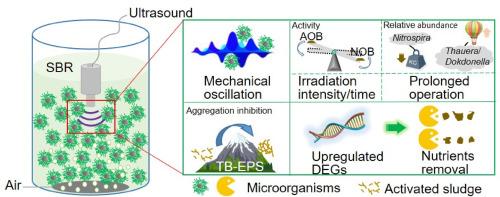间歇性弱超声改善 SBR 中污染物去除的新见解。
IF 8.1
2区 环境科学与生态学
Q1 ENVIRONMENTAL SCIENCES
引用次数: 0
摘要
为了阐明污染物去除率的提高与活性污泥特性、微生物组成以及差异表达基因(DEGs)调控之间的关系,我们对间歇性弱超声波与序批式反应器的结合进行了深入研究。在 12 °C、超声强度为 9.68 W/L、辐照时间为 10 分钟、间隔时间为 24 小时的条件下,COD、NH4+-N 和 TP 的去除率显著提高,分别为 93.10±1.51%、95.75±0.76% 和 92.52±0.95%。间歇性微弱超声波增强污染物去除的主要原因是刺激了微生物的新陈代谢,其中机械振荡而非自由基氧化促进了活性污泥絮体的松动,并促进了微生物的增殖。提高超声波强度或辐照时间可削弱增强氨氧化细菌活性和抑制亚硝酸盐氧化细菌活性的效果。结果表明,间歇性弱超声主要影响胞外聚合物(EPS),EPS 中的蛋白质氮比多糖对超声诱导的应激有更显著的作用。此外,超声辐照提高了 EPS 总结合相互作用能量曲线的能量势垒,从而抑制了活性污泥的聚集。在长时间的运行过程中,盛行的反硝化菌属 Thauera 的相对丰度增加了 90.3%,而完全好氧反硝化菌和亚硝酸盐产生菌 Dokdonella 的相对丰度增加了 68.7%。间歇性微弱超声诱导了微生物代谢相关 DEGs 途径的增强,这是污染物去除率提高的主要原因。这些发现为研究间歇性弱超声增强生物废水处理效果的机制提供了新的视角。本文章由计算机程序翻译,如有差异,请以英文原文为准。

New insights into the improved contaminants removal in SBR by intermittently weak ultrasound
The combination of intermittently weak ultrasound and sequencing batch reactor was thoroughly investigated to elucidate the relationship between enhanced contaminants removal and activated sludge characteristics, microbial composition, and regulation of differentially expressed genes (DEGs). At 12 °C, irradiation with an ultrasound intensity of 9.68 W/L, an irradiation time of 10 min, and an interval time of 24 h led to significant increases in COD, NH4+−N, and TP removals with the rates of 93.10 ± 1.51%, 95.75 ± 0.76%, and 92.52 ± 0.95%, respectively. The intermittently weak ultrasound enhanced contaminants removal was primarily attributed to the stimulated microbial metabolism, in which the mechanical oscillation rather than free radical oxidation facilitated the loosening of activated sludge flocs and promoted microorganism proliferation. Elevating the ultrasound intensity or irradiation time could weaken the effect of enhancing ammonia−oxidizing bacteria activity and suppressing nitrite−oxidizing bacteria activity. The results revealed that intermittently weak ultrasound primarily affected the extracellular polymeric substances (EPS), with protein nitrogen playing a more significant role than polysaccharide within EPS against ultrasound−induced stress. Furthermore, ultrasound irradiation elevated the energy barrier in total−binding EPS interaction energy curves, thereby inhibiting activated sludge aggregation. Over prolonged operation, the relative abundance of the prevalent denitrifying genus Thauera increased by 90.3%, whereas that of the fully aerobic denitrifier and nitrite producer Dokdonella increased by 68.7%. The intermittently weak ultrasound induced enhancement of microbial metabolism−related DEGs pathways, which served as the main contributor to the improved contaminants removal. These findings provide novel insights into the mechanisms by which intermittently weak ultrasound enhances the effectiveness of biological wastewater treatment.
求助全文
通过发布文献求助,成功后即可免费获取论文全文。
去求助
来源期刊

Chemosphere
环境科学-环境科学
CiteScore
15.80
自引率
8.00%
发文量
4975
审稿时长
3.4 months
期刊介绍:
Chemosphere, being an international multidisciplinary journal, is dedicated to publishing original communications and review articles on chemicals in the environment. The scope covers a wide range of topics, including the identification, quantification, behavior, fate, toxicology, treatment, and remediation of chemicals in the bio-, hydro-, litho-, and atmosphere, ensuring the broad dissemination of research in this field.
 求助内容:
求助内容: 应助结果提醒方式:
应助结果提醒方式:


